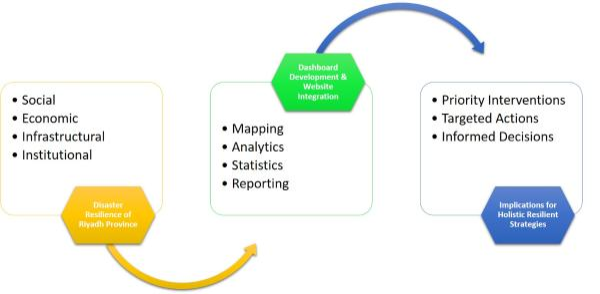Strategies and Implications
There has been a significant growth of urban development in the Kingdom of Saudi Arabia (KSA) for the past few years, especially in bigger cities, such as Riyadh. While the region's climate is hot and arid, several risks are considerable (e.g., flash flooding, heatwaves, and storms etc.). While all major cities in Saudi Arabia face susceptibility to disasters, such as flash floods, Riyadh experienced at least seven such disasters in the past decades, resulting in more than 160 fatalities and substantial socio-economic losses and infrastructural damages. This situation puts pressure on local bodies and institutional capacities are tested to their limits in order to provide assistance for recovery and bouncing back to normal.
Under such conditions, it is crucial that urban planning and design in KSA, particularly in bigger cities harboring millions of people, reflect reasonable considerations of disasters, resilience, and climate change impacts, which is imperative to pursue long-term urban sustainability. The development of a knowledge base for resilience management in Riyadh could offer significant opportunities for government and local bodies in the context of resilience building and long-term sustainability. This knowledge base could serve as a foundation for devising effective and informed action plans to enhance the city's overall resilience and address specific issues within different sub-domains (i.e., social, economic, infrastructural, and institutional). The framework developed for and the lessons learned from Riyadh could also provide valuable references for other major disaster-hit cities in KSA (e.g., Makkah, Medina, and Jeddah). While the primary access to such platforms remains with the government, there is merit in considering adopting an open-data policy to make the online portals accessible to the public under the supervision of government and official authorities. By doing so, residents, private companies, and other stakeholders, such as planning firms, risk and sustainability practitioners, and relevant companies, can gain access to such useful and comprehensive information. This information would empower them to make better-informed decisions, particularly in understanding the resilience situation of different neighborhoods. For instance, private companies may find the spatial approach particularly valuable as it provides detailed information on neighborhoods where interventions could be directed.
This information is crucial for making major cities more attractive and less vulnerable to the impacts of natural hazards. The accessibility of such platforms to communities can foster public participatory policymaking at the local level, influencing the overall resilience of major cities. This approach aligns with a people-centric disaster risk management strategy, as it encourages community engagement, awareness, and involvement in decision-making processes—which is well implemented in developed nations to tackle the adversities brought by disasters in the face of climate change.

From resilience assessment to informed planning